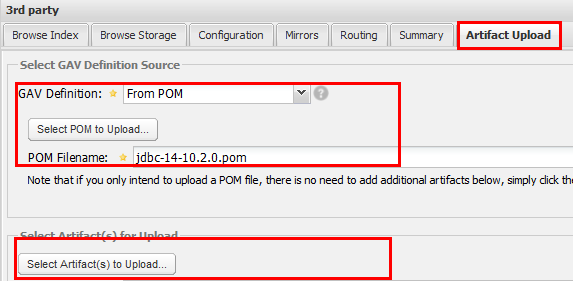maven私服配置
来源:互联网 发布:开源 文档系统 php 编辑:程序博客网 时间:2024/04/29 15:52
1、配置Nexus为maven的私服
第一种方式:在项目的POM中如下配置
<repositories> <repository> <id>nexus_public</id> <url>http://localhost:8081/nexus/content/groups/public/</url> <releases> <enabled>true</enabled> <releases> <snapshots> <enabled>true</enabled> <snapshots> </repository> </repositories> <pluginRepositories> <pluginRepository> <id>nexus_public</id> <url>http://localhost:8081/nexus/content/groups/public/</url> <releases> <enabled>true</enabled> <releases> <snapshots> <enabled>true</enabled> </snapshots> </pluginRepository> </pluginRepositories>注意:这样的配置(第一个仓库是代码库,第二个是插件库)只对当前的Maven项目有效。实际的项目开发中,我们都想着一次配置就能让本机的所有Maven项目都使用Maven私服,那么我们就要用到下面的方法。
第二种方式:在settings.xml中如下配置:
<settings>... <profiles> <profile> <id>nexus</id> <repositories> <repository> <id>nexus_public</id> <url>http://localhost:8081/nexus/content/groups/public/</url> <releases> <enabled>trueenabled> </releases> <snapshots> <enabled>true</enabled> </snapshots> </repository> </repositories> <pluginRepositories> <pluginRepository> <id>nexus_public</id> <url>http://localhost:8081/nexus/content/groups/public/</url> <releases> <enabled>true</enabled> </releases> <snapshots> <enabled>true</enabled> </snapshots> </pluginRepository> </pluginRepositories> </profile></profiles><activeProfiles> <activeProfile>nexus</activeProfile></activeProfiles>...settings>Maven提供的profile是一组可选的配置,可以用来设置或者覆盖配置默认值。有了profile,你就可以为不同的环境定制构建。
上面的配置中,使用了一个id为nexus的profile,这个profile包含了相关的仓库配置,同时配置中又使用了activeProfiles元素将nexus这个profile激活,这样当执行Maven构建的时候,激活的profile会将仓库配置应用到项目中去。
通过上面的配置,我们会发现Maven不仅会从Nexus下载构件外还会从中央仓库下载构件构件,为什么呢?因为超级POM文件定义了一个为central的远程仓库,如果这个ID没有被覆盖,那么请求下载构件时还可能会从central标识的远程仓库下载。既然是私服,那么我们就只希望Maven下载请求都仅仅通过Nexus。我们可以通过镜像实现这一需求。可以创建一个匹配任何仓库的镜像,镜像的地址是私服,这样Maven对任何仓库的构件下载请求都会转到私服中。
central的意思其实是重写了超级POM的资源库,那么这里通过重写导致覆盖,重要的是,镜像效果导致直接走镜像,而不会去理会这些资源库配置了,所以基本上url也失去了意义。不过对于快照和发布版本是否进行更新下载还是要靠这个配置来决定的,只有这个配置决定继续更新时才会走镜像下载资源,镜像其实是像在镜像内部寻找资源,如果没有则会在镜像配置的远程仓库下载资源到镜像中。
把上面的配置修改为如下配置:
<settings>...<mirrors> <mirror> <id>local_mirror</id> <mirrorOf>*</mirrorOf> <name>local_mirror</name> <url>http://localhost:8081/nexus/content/groups/public/</url> </mirror></mirrors><profiles> <profile> <id>nexus</id> <repositories> <repository> <id>central</id> <url>http://repo.maven.apache.org/maven2</url> <releases> <enabled>true</enabled> </releases> <snapshots> <enabled>true</enabled> </snapshots> </repository> <pluginRepositories> <pluginRepository> <id>central</id> <url>http://repo.maven.apache.org/maven2</url> <releases> <enabled>true</enabled> </releases> <snapshots> <enabled>true</enabled> </snapshots> </pluginRepository> </pluginRepositories> </profile></profiles><activeProfiles> <activeProfile>nexus</activeProfile></activeProfiles>...</settings>注意:以上两种方法都是配置下载的地址,也就是说项目需要下载插件时、下载代码时请求的地址。如果想要上传自己的代码,那么还需要如下配置,也就是部署构件到私服。
2、部署构件到私服
我们在实际开发过程是多个人的,那么总有一些公共模块或者说第三方构件是无法从Maven中央库下载的。我们需要将这些构件部署到私服上,供其他开发人员下载。用户可以配置Maven自动部署构件至Nexus的宿主仓库,也可以通过界面手动上传构件。
第一种方式:使用Maven部署构件到Nexus私服上
日常开发的快照版本部署到Nexus中策略为Snapshot的宿主仓库中,正式项目部署到策略为Release的宿主仓库中,POM的配置方式如下(这个配置文件同样可以写在settings.xml文件中):
<distributionManagement> <repository> <id>local_nexus_releases</id> <name>core Release Repository</name> <url>http://localhost:8081/nexus/content/repositories/releases/</url> </repository> <snapshotRepository> <id>local_nexus_snapshots</id> <name>core Snapshots Repository</name> <url>http://localhost:8081/nexus/content/repositories/snapshots/</url> </snapshotRepository></distributionManagement>Nexus的仓库对于匿名用户只是只读的。为了能够部署构件,我们还需要再settings.xml中配置验证信息(其中,验证信息中service的id应该与POM中repository的id一致):
<servers> <server> <id>local_nexus_releases</id> <username>admin</username> <password>admin123</password> </server> <server> <id>local_nexus_snapshots</id> <username>admin</username> <password>admin123</password></server></servers>第二种方式:在Nexus界面上手动部署第三方构件至私服
我们除了自己的构件要部署到Nexus私服上外,我们有可能还要将第三方构件(如:SQLService的JDBC)部署到Nexus上。这个时候,在Nexus界面上选择一个宿主仓库(如3rd party),再在页面下方选择Artifact Upload选项卡。填写对应的Maven坐标。然后点击“Select Artifact(s) for Upload”按钮从本机选择要上传的构件,然后点击“Add Artifact”按钮将其加入到上传列表中。最后,单击页面底部的“Upload Artifact(s)”按钮将构件上传到仓库中。

上传成功之后,就可以查看结果了:

原文地址:https://my.oschina.net/heweipo/blog/481047
- maven私服配置
- Maven 私服配置
- maven私服配置
- Maven 私服配置
- maven配置私服
- maven私服的配置
- maven nexus私服配置
- 【MAVEN】配置私服Nexus
- maven-配置私服-3
- maven 配置私服 连接
- Maven基础配置--nexus私服配置
- Maven基础配置--nexus私服配置
- maven(13)------maven使用私服的settings.xml配置
- 对maven私服配置的说明
- maven 项目上传私服pom配置
- 14、Maven私服的配置
- maven配置私服,发布到私服
- maven私服禁用匿名访问配置
- listview点击事件和其子view点击事件冲突时。
- SpringMVC-基础篇-UerController
- webpack.config.js解析
- C语言调用System命令并获取命令的返回值
- HashMap和TreeMap的区别
- maven私服配置
- Struts2中的数据类型转换
- 为你的Web程序加个启动画面
- Spring学习笔记05--使用构造器装配属性
- static,final和abstract
- C语言字符串操作
- Android Studio Template插件收集
- 使用sql跨域连接数据库
- 用js验证敏感词汇(汉字)


